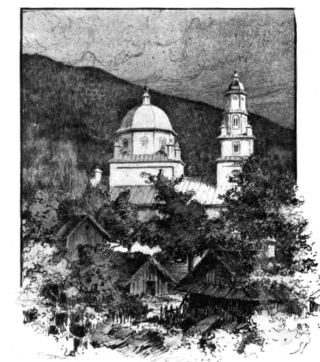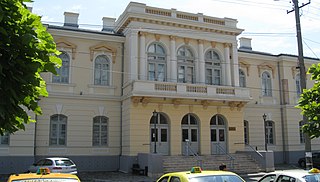
Moldavia is a historical region and former principality in Central and Eastern Europe, corresponding to the territory between the Eastern Carpathians and the Dniester River. An initially independent and later autonomous state, it existed from the 14th century to 1859, when it united with Wallachia as the basis of the modern Romanian state; at various times, Moldavia included the regions of Bessarabia, all of Bukovina and Hertsa. The region of Pokuttya was also part of it for a period of time.

Wallachia or Walachia is a historical and geographical region of modern-day Romania. It is situated north of the Lower Danube and south of the Southern Carpathians. Wallachia was traditionally divided into two sections, Muntenia and Oltenia. Dobruja could sometimes be considered a third section due to its proximity and brief rule over it. Wallachia as a whole is sometimes referred to as Muntenia through identification with the larger of the two traditional sections.

Northern Dobruja is the part of Dobruja within the borders of Romania. It lies between the lower Danube River and the Black Sea, bordered in the south by Southern Dobruja, which is a part of Bulgaria.

Tulcea is a city in Northern Dobruja, Romania. It is the administrative center of Tulcea County, and had a population of 65,624 as of 2021. One village, Tudor Vladimirescu, is administered by the city. It is one of six Romanian county seats lying on the Danube river.

Budjak, also known as Budzhak, is a historical region that was part of Bessarabia from 1812 to 1940. Situated along the Black Sea, between the Danube and Dniester rivers, this multi-ethnic region covers an area of 13,188 km2 (5,092 sq mi) and is home to approximately 600,000 people. The majority of the region is now located in Ukraine's Odesa Oblast, while the remaining part is found in the southern districts of Moldova. The region is bordered to the north by the rest of Moldova, to the west and south by Romania, and to the east by the Black Sea and the rest of Ukraine.

The Germans of Romania represent one of the most significant historical ethnic minorities of Romania since the late modern period onwards.
The history of coins in the area that is now Romania spans over a 2500-year period; coins were first introduced in significant numbers to this area by the Greeks, through their colonies on the Black Sea shore.

Islam in Romania is followed by only 0.4 percent of the population, but has 700 years of tradition in Northern Dobruja, a region on the Black Sea coast which was part of the Ottoman Empire for almost five centuries. In present-day Romania, most adherents to Islam belong to the Tatar and Turkish ethnic communities and follow the Sunni doctrine. The Islamic religion is one of the 18 rites awarded state recognition.

The Romanian government is the armiger in Romania. It exercises this right under the mandatory advice of the National Committee of Heraldry, Genealogy and Sigillography. The committee is subordinate to the Romanian Academy. All the coats of arms of Romanian institutions must be approved by this committee with two exceptions. The Romanian military is subject to the Ministry of National Defense Heraldric Committee, and Romanian law enforcement institutions are subject to the Ministry of Administration and Interior Heraldric Committee. Both of these committees may share members with the National Committee of Heraldry, Genealogy and Sigillography.

The Turks of Romania are ethnic Turks who form an ethnic minority in Romania. According to the 2011 census, there were 27,698 Turks living in the country, forming a minority of some 0.15% of the population. Of these, 81.1% were recorded in the Dobruja region of the country's southeast, near the Black Sea, in the counties of Constanța (21,014) and Tulcea (1,891), with a further 8.5% residing in the national capital Bucharest (2,388).

Slava Cercheză is a commune in Tulcea County, Northern Dobruja, Romania. Its name means the Cherkess (Circassian) Slava, in reference to the Dobrujan Circassian community that used to inhabit the village before the Russo-Turkish War (1877–1878). Besides the titular village, the commune also includes the village of Slava Rusă.

The military history of Romania deals with conflicts spreading over a period of about 2500 years across the territory of modern Romania, the Balkan Peninsula and Eastern Europe and the role of the Romanian military in conflicts and peacekeeping worldwide.

Bulgarians are a recognized minority in Romania, numbering 7,336 according to the 2011 Romanian census, down from 8,025 in 2002. Despite their low census number today, Bulgarians from different confessional and regional backgrounds have had ethnic communities in various regions of Romania, and during the Middle Ages Bulgarian culture has exerted considerable influence on its northern neighbour. According to one Bulgarian estimate, Romanian citizens of Bulgarian origin number around 250,000. According to the Romanian census of 2021, among the 5,975 ethnic Bulgarians, 3,583 were Roman Catholics, 1,977 were Romanian Orthodox and 21 were Serbian Orthodox.

Ismail County was a county (județ) of Romania between 1925 and 1938 and between 1941 and 1944, in Bessarabia, with the capital city at Ismail. It was also a county of Moldavia between 1856 and 1859, and of the Principality of Romania between 1859 and 1878, in Southern Bessarabia.
Doamna Ecaterina Cercheza was a Circassian noblewoman who became Princess consort of Moldavia by marriage to Vasile Lupu. As reported by Evliya Çelebi, her mother was the sister of Koca Dervish Mehmed Pasha who was the Grand Vizier of the Ottoman Empire from 1653 to 1654, and her sister was married to Islam III Giray, Khan of Crimea (1644–1654). She played a major role on personal and political decisions of her husband and son Ştefăniţă Lupu. Well known for her philanthropic activities, Doamna Ecaterina Cercheza became patron of the Moldavian monasteries and churches. She developed a strong reputation for her diplomatic and negotiating skills in time of crisis, in the absence of her husband and son.

The Tulcea Art Museum is an art museum located at 2 Grigore Antipa Street, Tulcea, Romania.

The Azizyie Mosque is a mosque located at 2 Independenței Street in Tulcea, Romania, in the Dobruja region.

Cahul County was a county of the Kingdom of Romania between 1925 and 1938 and between 1941 and 1944, in the historical region of Bessarabia, the successor of Cahul County.

The territorial evolution of Romania includes all the changes in the country's borders from its formation to the present day. The precedents of Romania as an independent state can be traced back to the 14th century, when the principalities of Moldavia and Wallachia were founded. Wallachia during its history lost several portions of its territory, either to the Ottomans or the Habsburgs. However, this land would be later essentially recovered in its entirety. Moldavia, on the other hand, suffered great territorial losses. In 1774, the Habsburgs invaded Bukovina and annexed it one year later, and in 1812, the Russian Empire took control of Bessarabia. Both territories were later exposed to powerful colonization policies. The principalities declared unification in 1859 as the Principality of Romania. This new state sought independence from the Ottoman Empire's vassalage, and in 1878, it fought a war against it alongside Russia. However, the latter would annex Southern Bessarabia, which was recovered decades before. Romania received Northern Dobruja as compensation, and would wage a war for the southern part against Bulgaria in 1913.
Cerchez, Cherchez and Cerkez are Romanian words meaning "Circassian". The Circassians were a prominent minority in Northern Dobruja during the 19th century. This region now belongs to Romania.



















